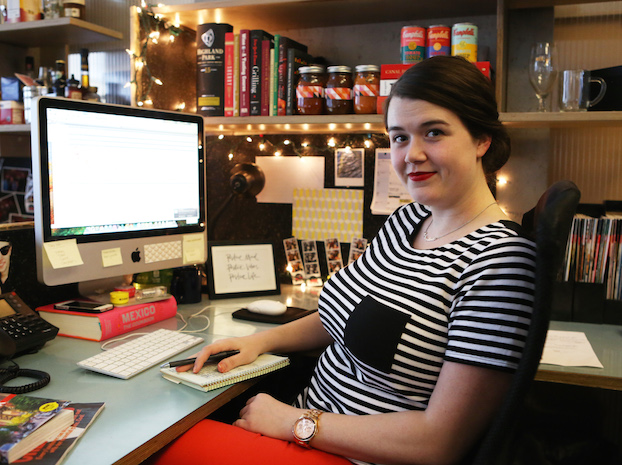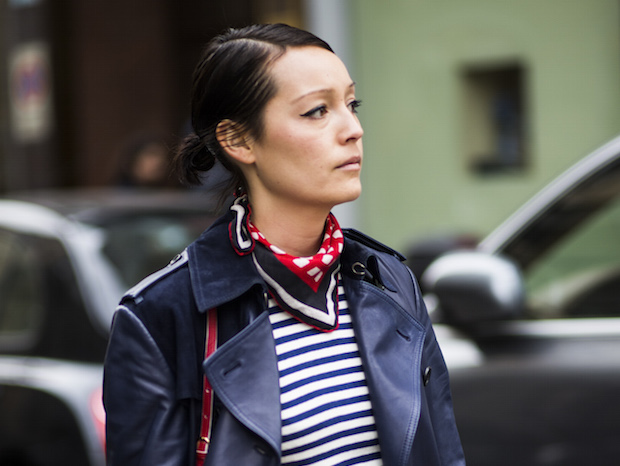Time Out‘s Assistant Editor serves up a lot of food (and drink) for thought about cooking up a career in gastronomic editorial.
What attracted you to covering food and drink? I’ve worked on a little bit of everything since my first internship, including local news, features, home design, travel, beauty, and food. Covering a variety of topics is what makes journalism fun and worthwhile. I chose this venture first and foremost because I wanted to work at Time Out New York. Second, the food world is an adventure all its own. A former editor once told me that she loved this subject because it can never be truly mastered—and I agree! That’s why it’s perfect for journalism: There are countless types and variations of cuisine, produce and proteins, preparation and cooking methods, presentations and pairings—it’s a never-ending pool of knowledge and discovery to be translated and shared with others.
Take us through your schedule; what is a typical day (and night) like? I try to arrive at least 15 minutes early in the morning to catch up on news from the night before. After monitoring blogs and other city-wide and culinary publications, I’ll pitch ideas at our a.m. blog meeting and then report and write the posts as soon as possible. Throughout the day, I continue to cover breaking news (restaurant and bar openings, chef and barkeep news, closings, events) on our site. After that, my day-to-day changes throughout the week. On Friday or Saturday nights, I’ll attend a new bar and write my review on Monday; pitch, report and write features for our section on Tuesday; follow restaurant and bar openings, schedule photo shoots, interview chefs/mixologists/owners, and write those stories on Wednesday. Thursday is close day, which means we finalize and polish everything in the magazine before sending it off to the printer. That can often mean a late night while you’re waiting for all the pieces of your section to come together: Your designer tweaking the layout, top editors combing your copy, fact-checkers confirming and changing details here and there. After work, I sometimes attend events like media previews and tastings.
When the chips are down, what is your favorite type of story/event to write/cover? Longform human-interest stories, in-depth profiles and other features that stick with you long after you’ve put them down (see: “The Hunt for El Chapo,” “The Girl in the Closet”). I’ll read them on my way to work, at lunch or before bed. Sometimes I get super nerdy and mark them up with notes. That’s where my passion for journalism comes from and, down the road, I want to be writing and/or editing stories like those every day.
What are the essential habits and skills you think a food and drink editor should possess? F&D editors need to be familiar with tasting notes and quick with their respective synonyms and, for the sake of logistics, can’t be picky eaters (I once had to try grasshoppers and maguey worms for a restaurant review). Other than that, it’s the same qualities needed to become any type of strong editor: hardworking, consistent and driven. Of course you’ve also got to have an eye for news and noteworthy stories, killer reporting skills, a clear writing style and respect for grammar and style.
What are the perks and drawbacks (if there are any) working at a city centric publication? The best part is getting to talk about New York all day. From editors in other sections, I get to hear about concerts and Broadway shows before they’re announced, which art galleries and exhibits to explore and which events to mark on my calendar. Time Out editors truly have their fingers on the pulse and it’s thrilling to be part of that. The only drawback can be our tight deadlines on the weekly print schedule, but that’s actually pushed me to grow tremendously.
What is a favorite published piece that you’ve contributed to? It’s so hard to choose a favorite, but my matcha tea story stands out because I caught and covered a growing trend before a lot of our competitors—even Bon Appetit. Plus, researching and reporting this piece was fascinating. I learned about the tea leaf harvest, ancient Japanese rituals, modern interpretations of the preparation, and unexpected uses for the green powder in dishes.
What can you not work/live without? My iPhone. It’s an all-in-one for recording interviews, taking photos for Time Out New York’s Instagram, capturing quotes from passersby for our “Word on the Street” column, giving cabbies directions to the outer-borough bars I’m reviewing, and keeping tabs on our competitors’ social media channels.
Complete this analogy: Fashion is to closet as food and drink is to__________. Your palate. Develop it along with your writing skills because it’s just as critical an asset.
What is an industry pet peeve of yours? Less of a pet peeve and more of a journalism-wide struggle, is being at the mercy of your sources. For me, that can be an unresponsive PR contact, an aloof chef or hard-to-reach bartender standing in the way of interviews, photo shoots or a news scoop. It can be frustrating when you’re on deadline, but you just have to keep at it, think outside the box, explore all possible resources, and never give up. If you remain persistent and focused, you’ll work through it and the story will come together in the end.
Twitter or Instagram? Instagram. I’m always checking it to keep up with notable figures in the food world (most chefs and bartenders announce projects, events and news there before Twitter and Facebook), plus other editors and photographers I admire. Decadent dishes and gorgeous cocktails are meant to be ‘grammed, right?
For a starving entry-level editor, where’s the best place to go on a Friday night in NY? One of my favorite spots to hit when I was an EA is Art Bar in the West Village. It’s an argyle-walled dive that’s been around for decades, slinging $8 half-pound burgers (with curly fries!) to both groups of friends and cozied-up couples in the oversize half-circle booths. The daily happy hour specials—half-off well drinks, house wine, and draft beers—are pretty hip, too. I still like stopping by there on occasion to sit in the pseudo-secret back room, on one of the plush couches by the fireplace.
What would your last meal (and drink) be? I’d want an array of some of my favorite things, served tapas-style: creamy brie cheese slathered on a fresh baguette, garlic-sautéed asparagus and portobello mushrooms, duck confit, chili-glazed ahi tuna, filet mignon in a red-wine reduction, carnitas-stuffed chile relleno, and crême brûlée. Oh, and a classic gin martini—with a twist.
Do you have any advice for people trying to break into the industry? Be diligent. If you’re in the application process, send out tailored cover letters and friendly follow-up emails without hesitation. Grab a coffee with editors you look up to (or even their assistants) to make connections and pick their brains informally. Never show up late and always send handwritten thank-you notes. Once you land the gig, don’t fall off the networking wagon. Exceed your editor’s expectations every day. And lastly, one thing I think we all have to remind ourselves from time to time, don’t compare yourself to your peers. Everyone’s path is unique, and you can always make edits as you go.
What word/phrase/motto do you live by? Mind the gap. It’s from a 2009 interview with Ira Glass that I first saw in college. He encourages all beginners in creative fields to strive toward closing the gap between the work they admire and the work they’re producing themselves. That means busting your butt and never quitting. It’s simultaneously uplifting and challenging, which is why when I’m feeling overwhelmed, I remind myself that all my time and effort is moving me closer to the other side of the gap.
Photographed by Lauren Spinelli.
Amanda Jean Black is a guest blogger at Ed2010, sharing stories from her site onthemasthead.com. When not hunting down publishing’s elite for an interview, you can find the native New Yorker obsessing about style and culture, shopping for designer streetwear, and jamming out to 90′s alt rock.




 Chatting with Rachael Wang, Style.com
Chatting with Rachael Wang, Style.com